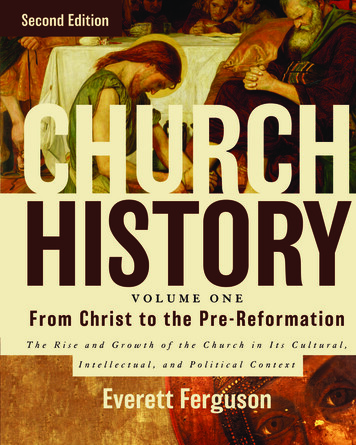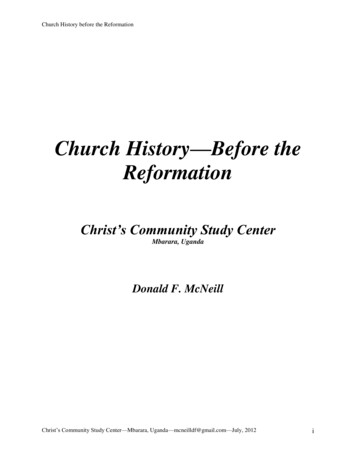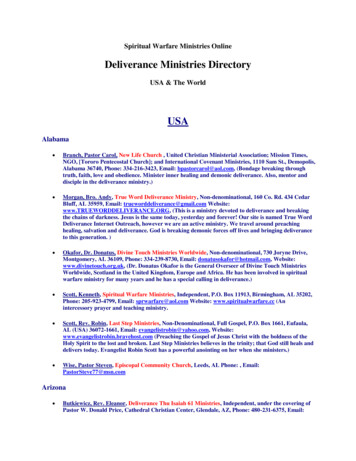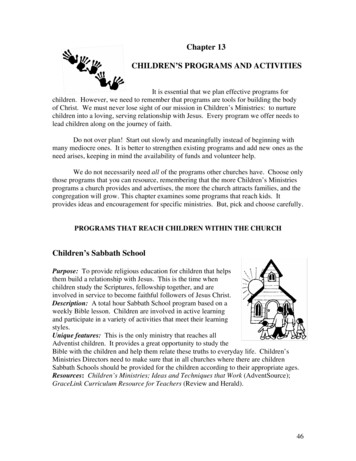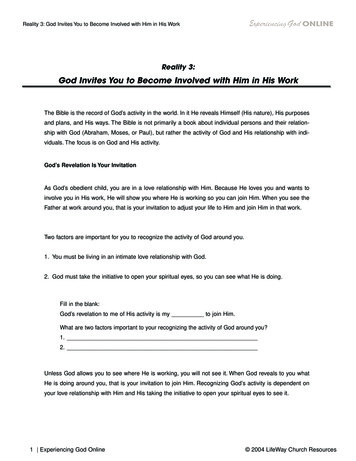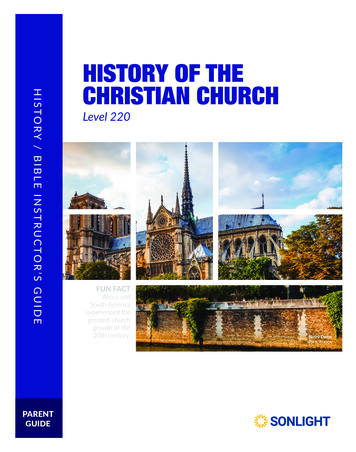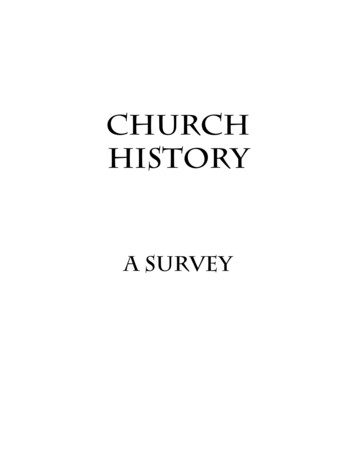
Transcription
ChurchHistoryA SURVEY
Church HistoryIntroductionWhy would you want to study a bunch of old, dead people?Well, why do you read and study the Bible? Doesn’t it tell you the story of a bunch ofold, dead people? True, its central character, Jesus Christ, is still alive, but everyoneelse has long since passed away. But we desire to learn all we can know about Peter,Paul, James, John, and Priscilla. Why not others?Hebrews 12:1 (NKJV)Therefore we also, since we are surrounded by so great a cloud of witnesses,let us lay aside every weight, and the sin which so easily ensnares us, and let usrun with endurance the race that is set before us,1There is this “great cloud of witnesses” watching us run our Christian race. Maybe, justmaybe, if we look back upon the lives of some of these witnesses we can run a betterrace.Christianity itself is deeply rooted in history. It involves two central groups of people –the Jewish nation and the body of Christ, the Church. The central figure of Christianity isJesus Christ, God come to earth as a Man. The Person and Work of Jesus is a realtime historical event. The birth, sacrifice, burial, and resurrection of Jesus are historicalevents and form the cornerstone of your faith.The entire story of the Bible is the unfolding of God’s plan in history. The Gospel offersredemption for a hurting world. A study of church history is the study of God at work inthe world carrying out His plan for mankind.You are a member of God’s church body. The history of the church is the story of yourfamily. Studying the church over the ages helps the modern church understandcontroversies and heresies. Cults were present in A.D. 200. the same as they arepresent today. To understand Christian doctrine in its context of history helps us toseparate fads and falsehoods from the truth of the Bible. The cults of today havealready been dealt with in the distant past.As a general comment, no two histories will view all events in the same fashion norplace emphasis in the same manner. What follows is a general survey of church history.Refer to the various sources, as well as many others that exist, for a more detailedstudy.So, why study church history? Because it is the story of your family tree. All of these“great cloud of witnesses” are your distant brothers and sisters!Jim ArthurJanuary 2004
BibliographyAnd Other InformationUnless noted, all Scripture taken from The New King James Version. Nashville:Thomas Nelson, 1996, c1982.“Century Events” are taken from Church History Institute, athttp://www.gospelcom.net/chi/index.php“One Hundred Key Events in Church History” taken from Church History Institute, athttp://www.gospelcom.net/chi/index.phpSuggested Sources for Further Study;Cairns, Earle E., Christianity Through the Centuries, Revised & Enlarged Edition,Grand Rapids: Academie Books, a division of Zondervan Publishing House,1954, 1981.Jones, Timothy Paul, Christian History Made Easy, Torrance, CA: RosePublishing, 1999.Noll, Mark, A., Turning Points, Decisive Moments in the History of Christianity,Grand Rapids: Baker Books, 1997.Schaff, P., & D. S. Schaff. History of the Christian Church. Oak Harbor, WA:Logos Research Systems, Inc., 1997.Shelley, Bruce L., Church History in Plain Language, Dallas: Word Publishing,1982.Vos, Howard F., Introduction to Church History, Nashville: Thomas NelsonPublishers, 1994.2
Church HistoryLesson 1The Church Commences to about AD 177Acts 1:4-8 (NKJV)And being assembled together with them, He commanded them not to departfrom Jerusalem, but to wait for the Promise of the Father, “which,” He said, “youhave heard from Me; 5 for John truly baptized with water, but you shall bebaptized with the Holy Spirit not many days from now.” 6 Therefore, when theyhad come together, they asked Him, saying, “Lord, will You at this time restorethe kingdom to Israel?” 7 And He said to them, “It is not for you to know times orseasons which the Father has put in His own authority. 8 But you shall receivepower when the Holy Spirit has come upon you; and you shall be witnesses toMe in Jerusalem, and in all Judea and Samaria, and to the end of the earth.”4Acts 2:1-4 (NKJV)When the Day of Pentecost had fully come, they were all with one accord in oneplace. 2 And suddenly there came a sound from heaven, as of a rushing mightywind, and it filled the whole house where they were sitting. 3 Then there appearedto them divided tongues, as of fire, and one sat upon each of them. 4 And theywere all filled with the Holy Spirit and began to speak with other tongues, as theSpirit gave them utterance.1Acts 2:14 (NKJV)14But Peter, standing up with the eleven, raised his voice and said to them, “Menof Judea and all who dwell in Jerusalem, let this be known to you, and heed mywords.First, let’s make clear of that which we speak –The Church is the universal, century spanning, “body of Christ” comprised of allbelievers of all ages between Pentecost of Acts 2:1 and the Rapture yet to come.1 Corinthians 12:27 (NKJV)Now you are the body of Christ, and members individually.27Ephesians 4:12 (NKJV)for the equipping of the saints for the work of ministry, for the edifying of thebody of Christ,121 Corinthians 10:16 (NKJV)The cup of blessing which we bless, is it not the communion of the blood ofChrist? The bread which we break, is it not the communion of the body of Christ?163
Romans 7:4 (NKJV)Therefore, my brethren, you also have become dead to the law through thebody of Christ, that you may be married to another—to Him who was raised fromthe dead, that we should bear fruit to God.4 When we speak, then, of church history, we are discussing the historical eventsand decisions that surround the people of Christ, those who are true believers ormembers of His church. We cannot judge if all members of this groups asdefined by history were truly saved, but all of the events form the historicalfoundation of the church as it exists today.For example, the Crusades were a series of events championed by the Church leadersof the day, but hindsight demonstrates the Crusades had little or nothing to do with thegospel of grace. Great cathedrals have been built with church funds adored bymasterpieces of art, yet, where is the gospel of grace? Was God or money the forcebehind their creation? Again, we do not know the answer to this question, but theartwork exists for our pleasure, use and enjoyment. The chart below demonstrates onepossible method of breaking down the centuries into manageable units of time forstudying church history.Periods of church history Ancient Apostolic 30-100 Ante-Nicene 100-313 Nicene 313-590 Medieval 590-1517 Age of Reformation 1517-1648 Age of Reason and Revival 1648-1789 Age of Progress 1789-1914 Age of Ideologies 1914-What we are about to study, then, involves the history of the church of Jesus Christ as itactually existed throughout the past twenty centuries. You will not agree with all of thetheology expressed during this period nor will you approve of all the people involved.However, a clear understanding of these events will help you to understand how ourdoctrine developed, why we have denominations, why the Roman Catholic Church isboth a cult and a major influence of church history, and many more similar questions.So come along and join us on this exciting trip . . .4
The ApostlesThe enemies of their Master insulted all of the apostles. They were called to seal theirdoctrines with their blood and nobly did they bear the trial. Tradition says that: Matthew suffered martyrdom by being slain with a sword at a distant city ofEthiopia.Mark expired at Alexandria, after being cruelly dragged through the streets of thatcity.Luke was hanged upon an olive tree in the classic land of Greece.John was put in a caldron of boiling oil, but escaped death in a miraculousmanner, and was afterward banished to Patmos.Peter was crucified at Rome with his head downward.James, the Greater, was beheaded at Jerusalem,James, the Less, was thrown from a lofty pinnacle of the temple, and then beatento death with a fuller s club.Bartholomew was flayed alive.Andrew was bound to a cross, whence he preached to his persecutors until hedied.Thomas was run through the body with a lance at Coromandel in the East Indies.Jude was shot to death with arrows.Matthias was first stoned and then beheaded.Barnabas of the Gentiles was stoned to death at Salonica.Paul, after various tortures and persecutions, was beheaded at Rome by theEmperor Nero.The Apostles were not the only ones to move about the world with the Gospel message.Acts 8:1 (NKJV)1Now Saul was consenting to his death. At that time a great persecution aroseagainst the church which was at Jerusalem; and they were all scatteredthroughout the regions of Judea and Samaria, except the apostles.Those “scattered” were the new believers. As they moved across the country-side, theytook the Gospel message with them, delivering it to their neighbors and others theyencountered along the way. One example of this spreading of the Gospel is found in thebook of Acts with the story of Philip and the Ethiopian eunuch (Acts 8:5; 26ff). While itcannot be stated with certainty, it is likely that visitors to Jerusalem who were convertedat Pentecost started the church at Rome. They took the Gospel message back homewith them.The pattern of the Apostles may be seen in the missionary journeys of Paul outlined inthe book of Acts. While many of the Apostles appear to have settled and ministered inone location, others traveled from town-to-town, as did Paul, spreading the Gospelmessage. Indeed, it is possible that Paul undertook one final journey following the endof the Book of Acts.Nothing is actually known about Paul’s life after Acts 28 except for a few stray traditionsthat have survived and the wishes he expressed in his letters. It is reasonably clear thatone cannot fit the events of 1 & 2 Timothy and Titus into the events recorded in Acts.5
Therefore, it appears Paul was released from prison after Acts 28, only to be laterarrested. 1 Timothy and Titus were written during this period of release and 2 Timothywritten after the apostle’s second arrest. A comparison of Titus 3:12 and 2 Timothy 4:21requires that at least two winters are involved in the time frame covered by the PastoralEpistles. Assuming that Paul more or less kept to the itinerary laid forth in his letters, the4th missionary journey would be approximately like this: Timothy is immediately sent to Philippi with news of Paul’s release (Phil 2:19-23)He went to Crete, leaving Titus behind (Titus 1:5)From there, he went to EphesusThen to Colosse to see Philemon (Philemon 22)He then probably returns to EphesusTimothy joins him either at Ephesus or Colosse and Paul asks Timothy to stay inEphesus (1 Tim 1:3, 4)Then to Macedonia (1 Tim 1:3)This may have included Philippi (Phil 2:24), Nicopolis (Titus 3:12)The winter having passed, if Paul went to Spain as he wished (Rom 15:24, 28) itwould have been in the spring. Clement of Rome, writing around 100, talks ofPaul “come to the extreme limit of the west.” This could mean Spain. Somecommentators view this as meaning Britain. There is a tradition that says Titusaccompanied Paul on this journey, wherever he went.He would then revisit Timothy in Ephesus (1 Tim 3:14, 15).He would then have passed through the seaport of Miletus where he had to leavean ill Trophimus behind (2 Tim 4:20)Next to Troas where he stayed with Carpus and left his cloak and some booksbehind (2 Tim 4:13).From there to Corinth where Erastus left the party (2 Tim 4:20; cf Rom 16:23).And on to Rome from where he sits in prison and writes 2 Timothy.His arrest could have occurred anywhere along this route commencing perhapsat Miletus, although Troas is a better suggestion, explaining why the clothing andbooks were left with Carpus.A comparison of Acts and 2 Timothy shows the second imprisonment was not ascomfortable as the first. Paul was restricted to a cell in chains (2 Timothy 1:16;2:9) and Onesiphorus had to search him out with great difficulty (2 Timothy 1:17)In addition, we may note in the Acts the pattern of dispute resolution used by the Churchduring the first several centuries of its existence. Acts 15 records the events of theJerusalem Council, a meeting of church leaders to resolve the question of whether or nota new believer needed to be circumcised. Several times during the 400 years, thechurch would meet to hold councils to resolve major theological issues.With the exception of the Apostle John, the first generation of church leaders had diedby A.D. 70. The second generation includes Timothy, Titus and many others named inthe epistles. These are the disciples or students of the Apostles. All of the Apostleswould have had their Timothy’s, even if we do not know their names. Those whopreached in the First, Second, Third, and, perhaps, Fourth centuries earned the name“Church Fathers.” To a great extent, these are the men who formed the “systematicdoctrine” of the church as they fought for the Apostle’s doctrines and clarified meaningsof terms found in the Scriptures.6
7
Church FathersIn general, the references to church fathers are broken down based upon time periodsand their method of protecting or defending the Gospel. The first group is the Apostolicor Post-Apostolic Fathers (c.95-150, Clement, Ignatius, Papias, Polycarp). The secondgroup is the Apologists (c.140-200, Justin Martyr, Tatian, Tertulian), followed by thePolemicists (c. 180-225, Irenaeus, Hippolytus, Tertulian, Cyprian), with the fourth groupbeing the Scientific Theologians (c. 225-400, Augustine, Origen, Cyril, Athanasius,Jerome, Ambrose, Theodore, John Chrysostom). The Fathers are also referred torelative to their time relationship to the Nicene Council (A.D. 325), resulting in theApostolic Fathers (second century), the Ante-Nicene Fathers (second, third centuries),the Nicene Fathers (fourth century),and the Post-Nicene Fathers (fifth century).We know from Scriptures that the persecution of Acts 8 is Jewish in nature. Likewise, itis Herod who undertakes the persecution in Acts 12 that results in the death of theApostle James, brother of John. Both of these persecutions send Christians out ofJerusalem.It also appears that by A.D. 45, there were Christians along the Mediterranean coast inplaces like Antioch, but aside from Jerusalem the only other pocket of Christiansappears to be in Rome. Paul’s missionary journeys commence around A.D. 50. Hisletter to the Galatians was written around A.D. 49. At the same time that Paul movesChristianity along the Mediterranean coast into Asia Minor (Turkey) on across towardGreece and Rome, persecutions in Rome would move Christians outward in alldirections from that city.In the summer of A.D. 64 Rome burns. While many stories exist about this event, thecitizens of Rome blamed Nero, who, in turn, blames the Christians and persecutes them.This is the first clear indication within the Roman Empire that Christianity is a separatereligion from Judaism. Many Christians die, but many more flee the city. The Christiansbelieved in only one God, while taking no note of social status. This belief excludes theemperor from being deity. This offended the Romans. As such, the emperors wouldview Christianity as an attack upon the existing social structure of Rome.While Nero was busy attacking the Christians in Rome, the empire was also attackingthe Jews in the Holy Lands, first through the office of the Roman ruler Florus (A.D. 64)and then through the offices of General Vespasian. Nero ordered the General to takefull control of Galilee and Judea. At Nero’s death, Vespasian returned to Rome tobecome Emperor, but sent an army back to Jerusalem to stop all of the revolts theRomans “discovered.” The net result of this was the scattering of Jews and Christiansalike. This also had a chilling effect upon relationships between the Jews and theChristians, with the Jews once again directly persecuting the Christians.With Vespasian’s son, Domitian, becoming emperor around A.D. 81, the empire onceagain persecuted the Christians. Domitian claimed the title “Lord and God,” an obviousaffront to the Christians. It should be noted that Domitian also persecuted the Jews.This persecution continued under Trajan.8
The church fathers of the time took the approach of attempting to “prove” to the Romansthat Christianity was not a threat to the empire. These scholars were called “apologists”from the Greek word apologia, meaning a formal justification or reply, that is, a reasonedargument. They did not attempt to convert the Romans, merely prove to them theChristians were not criminals and should not be persecuted. The best known of thisgroup was Justin, who was beheaded in A.D. 165, earning him the name of JustinMartyr.Ironically, while the apologists may have helped shape later doctrinal statements of thechurch, it was the attitudes of the Christians towards morals, the social standing ofpeople (or, rather, the ignoring thereof), and the outward personal relationship with acaring God that won individual Romans over to Christ. Many Romans becamedisillusioned with the moral / social fabric of Roman and converted to Christianity duringthis period.9
First Century Events The words and sayings of Jesus are collected and preserved. New Testament writingsare completed. A new generation of leaders succeeds the apostles. Nevertheless, expectation still runshigh that the Lord may return at any time. The end must be close. The Gospel taken through a great portion of the known world of the Roman empire andeven to regions beyond. New churches at first usually begin in Jewish synagogues around the empire andChristianity is seen at first as a part of Judaism. The Church faces a major crisis in understanding itself as a universal faith and how it isto relate to its Jewish roots. Christianity begins to emerge from its Jewish womb. A key transition takes place at thetime of Jewish Revolt against Roman authority. In 70 AD Christians do not take part inthe revolt and relocate to Pella in Jordan. The Jews at Jamnia in 90 AD confirm the canon of the Hebrew Scriptures. The samebooks are recognized as authoritative by Christians. Persecutions test the church. Jewish historian Josephus seems to express surprisethat they are still in existence in his Antiquities in latter part of first century. Key persecutions include Nero at Rome who blames Christians for a devastating firethat ravages the city in 64 AD He uses Christians as human torches to illumine hisgardens. Emperor Domitian demands to be worshiped as "Lord and God." During his reign thebook of Revelation is written and believers cannot miss the reference when it proclaimsChrist as the one worthy of our worship.AD 100 (TWO GENERATIONS AFTER CHRIST) Percent Christian: 0.6% Breakdown: 70% nonwhite, 30% white Evangelization: 28.0% of world Scriptures: 6 languages Total martyrs since AD 33: 25,000 (1.2% of all Christians ever; rate 370 per year)Source: David Barrett.10
Second Century Events The Lord has not returned as soon as expected, so organization is needed to continuethe ministry, resist persecution, oppose heretical teachings, and spread the word. Thusthe office and role of the bishop becomes stronger. While persecution continues intermittently from without, heresies pose major dangersfrom within and must be answered. Heresies include:GNOSTICISM -- A kind of New Age movement that claimed special knowledge.MARCIONISM -- An attempt to reduce the Scriptures--both the Hebrew and ChristianScriptures -- to a few select booksMONTANISM -- A charismatic movement that got carried away with new revelations,prophecies, and judgmental attitudes toward other Christians. Apologists, or explainers of the faith, emerge to combat heresy and answer thechurch's opponents. Key apologists include Irenaeus and Justin Martyr. The churches are not legal and have no public forum or church buildings. Localpersecution can break out at any time. A profound public witness emerges as Christiansare put to death because they will not deny the faith at any cost. Examples: Martyrdomof 84-year-old bishop Polycarp (AD 155) and a whole group mercilessly tortured atLyons in AD 177. The strongest centers of the Church are Asia Minor and North Africa. Rome is also acenter of prestige. The church continues its amazing spread reaching all classes, particularly the lower.Callistus--a former slave--actually becomes bishop of Rome and makes claims forspecial importance of the Roman bishop.AD 200 (SIX GENERATIONS AFTER CHRIST) Percent Christian: 3.5% Breakdown: 68% nonwhite, 32% white Evangelization: 32% of world Scriptures: 7 languages Total martyrs since AD 33: 80,000 (0.5% of all Christians ever; rate 48 per year)Source: David Barrett.11
One Hundred Key Events in Church HistoryPart 1: From Nero to the Battle of ToursDetails from the arch erected to honor Titus' triumph over the JewsYear and event64Fire ravages Rome. Emperor Nero blames Christians and unleashes persecution.70Titus destroys Jerusalem and its temple. Separation deepens between Christianity andJudaism.about 150Justin Martyr writes his First Apology, advancing Christian efforts to address competingphilosophies.about 156Polycarp, an eighty-six-year-old bishop, inspires Christians to stand firm underopposition.177Irenaeus becomes bishop of Lyons and combats developing heresies within the Church.about 196Colorful and cantankerous Tertullian begins writings that earn him the reputation ofbeing the "Father of Latin Theology."about 205The gifted North African Origen begins writing. He headed a noted catechetical school inAlexandria.251Cyprian, bishop of Carthage, publishes his influential work Unity of the Church. He wasmartyred in 258.12
270Antony gives away his possessions and begins life as a hermit, a key event in thedevelopment of Christian monasticism.312Constantine is converted after seeing a vision of the cross. He becomes a defender andadvocate of the oppressed Christians.325The Council of Nicea addresses debates perplexing the Church and defines the doctrineof who Jesus really was.367Athanasius' Easter Letter recognizes the New Testament Canon, listing the same bookswe have now.385In Milan, Bishop Ambrose defies the Empress, helping establish the precedent of Churchconfrontation of the state when necessary to protect Christian teaching and oppose thestate.387Augustine of Hippo is converted. His writings became bedrock for the Middle Ages. TheConfessions and City of God are still read by many.398John Chrysostom, the "golden tongued" preacher is made bishop of Constantinople andleads from there amidst continuing controversies.405Jerome completes the Latin "Vulgate" version of the bible that becomes the standard forthe next one thousand years.432Patrick goes as a missionary to Ireland--taken there as a teenager as a slave. He returnsand leads multitudes of Irish people to the Christian faith.451The Council of Chalcedon confirms orthodox teaching that Jesus was truly God and trulyman and existed in one person.529Benedict of Nursia establishes his monastic order. His "rule" becomes the mostinfluential for centuries of monasticism in the West.563Columba goes as a missionary to Scotland. He establishes the legendary monasticmission center at Iona.13
590Gregory becomes Pope Gregory I, known as "the Great." His leadership significantlyadvances the development of the papacy and has enormous influence on Europe.664Synod of Whitby determines that the English church will come under the authority ofRome.716Boniface, the "Apostle of Germany," sets out as a missionary to bring the gospel topagan lands.731The "Venerable" Bede completes his careful and influential Ecclesiastical History of theEnglish Nation.732At the Battle of Tours, Charles Martel turns back the Muslim invasion of Europe.14
15
Church HistoryLesson 2They Had Cults, Too! AD 90 to AD 2501 John 2:18-19 (NKJV)Little children, it is the last hour; and as you have heard that the Antichrist iscoming, even now many antichrists have come, by which we know that it is thelast hour. 19 They went out from us, but they were not of us; for if they had beenof us, they would have continued with us; but they went out that they might bemade manifest, that none of them were of us.18Why a fish?Why is a fish the early symbol of Christianity?If you carefully review the letters of the New Testament, you will quickly discover that themajor purpose of virtually all of them is to combat some type of false teaching that hasinvaded or is about to invade the church’s teachings. The Bible is not a book written inthe format of what we would call systematic theology. Rather, it is written as letters toexisting churches, about existing problems of the time. The New Testament writers tookthe teachings of Christ and explained to the local churches how to uphold Christ’steachings within a given set of circumstances.Systematic theology is a uniform statement of belief on a given topic. For example,nowhere within Scripture is the doctrine of the Trinity explained or defended. This task isthe world of systematic theology. As we look at the first several hundred years of thechurch’s life we will discover that systematic theology was born in response to the ongoing problems of cults and false teachings that invaded the church. As false teachersproduced false doctrine, the Church Fathers defended Christianity by providing a“correct” statement of the doctrine involved in the controversy. Thus, systematictheology was born in the cradle of false doctrines.Terms to RememberTHEOLOGY is the study of God. This, in turn, has led man to definebeliefs in God in general “catch-all” terms. There is some benefit tounderstanding these terms, at least in broad concepts. It will help usplace religions together as to their overall worldviews of God.ATHEISM, outright denial of the existence of God, is a position that manyclaim to hold. If you are an atheist, you believe that man is alone and lifeis meaningless. This is the Soviet cosmonaut’s view of the universe (“Ican’t see God, so He must not exist.”). It is contradicted by evidence innature, the conscience, and the spiritual makeup of the individual, as well16
as by biblical teaching. At heart, it is a rejection of the self-revelation ofthe personal God of the Bible, who has on innumerable occasionscommunicated with human beings for their benefit. Many people arepractical atheists because they have not bothered to inquire about theexistence and character of God.AGNOSTICISM, the belief that one cannot know if God exists or not,amounts to a suspension of knowledge. As with atheism, it rejects themany self-disclosures of God. It is an affront to the God Who hasspoken, is based on pride, and offers no hope for life now or after death.Both positions are contrary to the basic makeup of human beings, whodesperately need contact with their Creator and have the spiritualcapacity to interact with Him.PANTHEISM is an often sophisticated but actually illogical view of God.It denies the existence of a personal God who interacts intelligently withhuman beings. Instead, God is the same thing as the universe, and, inturn, the universe of God. Of course, in this view we are part of God andHe is part of us. If you are a pantheist, then you have to conclude that atany given moment you are sitting or standing on God! It actuallysacrifices God’s personhood for His infinity, and, in some forms of theview, makes God physical, although in some variations everything issupposedly nonmaterial and spiritual, including the universe. Pantheismis an attempt to reduce God to identity with His creation.POLYTHEISM, the belief in a plurality of gods (equal or differing in rank)is prevalent throughout the world, as is pantheism. This view clearlycontradicts the biblical teaching that there is only one deity and that He isunique in power and position. In polytheism in general, the adherent cannever know if he has pleased the right god. We might call this the AlkaSeltzer view of God. Like a medicine that covers all the bases,polytheism, by encouraging placating all the gods to obtain favor,assuages the conscience, or at least it attempts to!DEISM is the view that God exists and can interact with human beings,but has withdrawn from contact with them. In some forms it involvesdenial of the Trinity, the incarnation, miracles, and other orthodoxdoctrines.MONOTHEISM is the belief in only one God, a God who is active in theuniverse. Christianity, Judaism, and Islam are the only monotheisticreligions.MONISM is the belief of all-in-one. It is the unity of all reality, not thebelief in a single God. It is similar in results to pantheism.APOSTASY is generally defined as the determined, willful rejection of Christ andHis teachings by a Christian believer (Heb. 10:26-29; John 15:22). This isdifferent from false belief, or error, which is the result of ignorance. The problemis whether or not a true believer can reject Christ. A better view is that apostasy17
involves long-time “members” of the “professing church,” those who declare withtheir mouths they are Christians, a position not supported by their hearts.A CULT, then, is a perversion or distortion of biblical Christianity. It is a rejectionof the historic teachings of the Christian church. A cult is a group of peoplebased upon someone’s interpretation of the Bible and is characterized by majordeviations from orthodox Christian beliefs. This deviation is particularlyconcerned with the Trinity and the Person of Jesus Christ.The church cannot defend the faith unless it understands the faith. The history of theearly church is the story of the church leaders and members coming to understand theirstatement of faith.ORTHODOXY is the method of referring to the standard of beliefs held by theChurch of Christ. It is the list of “doctrines” believed to be truth.DOCTRINE is t
Church History Lesson 1 The Church Commences to about AD 177 Acts 1:4-8 (NKJV) 4 And being assembled together with them, He commanded them not to depart from Jerusalem, but to wait for the Promise of the Father, “which,” He said, “you have heard from Me; 5 for John truly baptized with water, but you shall be b

